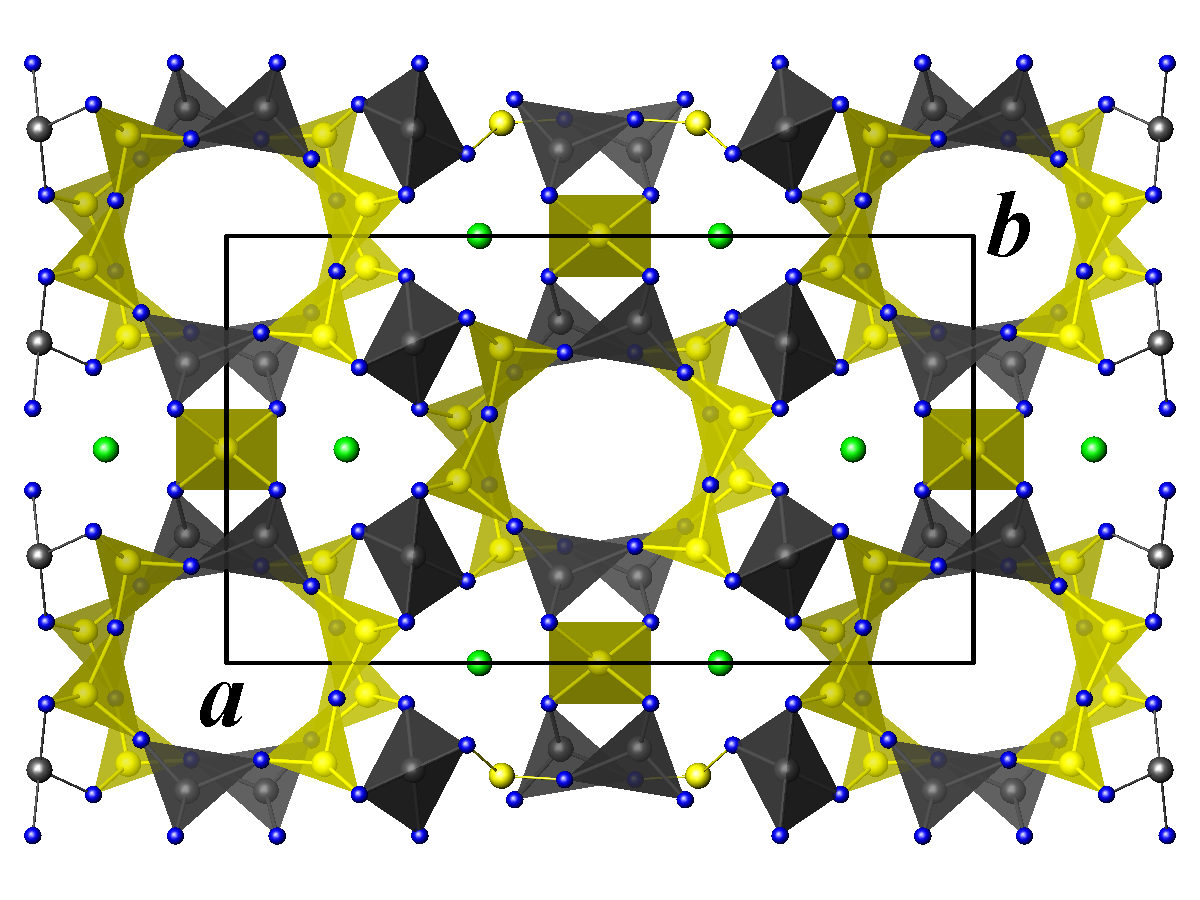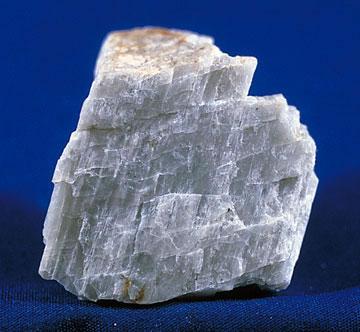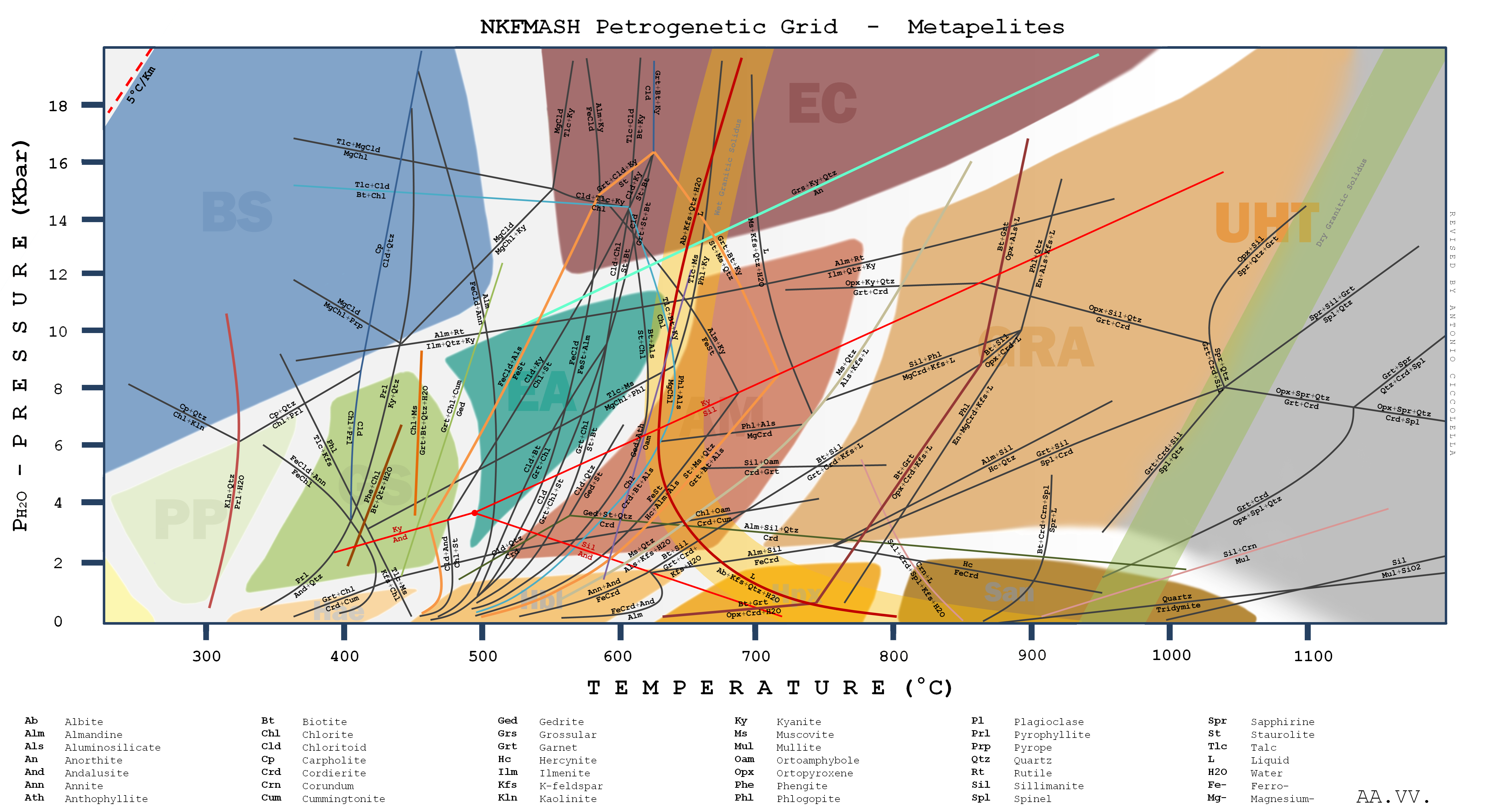|
Cordierite
Cordierite (mineralogy) or iolite (gemology) is a magnesium iron aluminium cyclosilicate. Iron is almost always present, and a solid solution exists between Mg-rich cordierite and Fe-rich sekaninaite with a series formula: to . A high-temperature polymorph exists, indialite, which is isostructural with beryl and has a random distribution of Al in the rings. Cordierite is also synthesized and used in high temperature applications such as catalytic converters and pizza stones. Name and discovery Cordierite, which was discovered in 1813, in specimens from Níjar, Almería, Spain, is named after the French geologist Louis Cordier (1777–1861). Occurrence Cordierite typically occurs in contact or regional metamorphism of pelitic rocks. It is especially common in hornfels produced by contact metamorphism of pelitic rocks. Two common metamorphic mineral assemblages include sillimanite-cordierite-spinel and cordierite-spinel-plagioclase- orthopyroxene. Other associated mine ... [...More Info...] [...Related Items...] OR: [Wikipedia] [Google] [Baidu] |
Sekaninaite
Sekaninaite ((Fe+2,Mg)2Al4Si5O18) is a silicate mineral, the iron-rich analogue of cordierite. It was first described in 1968 for an occurrence in Dolní Bory, Vysočina Region, Moravia, Czech Republic, and is now known also from Ireland, Japan, and Sweden. It was named after a Czech mineralogist, Josef Sekanina (1901–1986). In Brockley on Rathlin Island, Ireland sekaninaite occurs in bauxitic clay within the contact aureole of a diabase intrusive plug. Structure and composition The chemical formula of sekaninaite is: (Fe^2+, Mg^2+)2 l4Si5O18\mathitH2O. Grapes et al. (2010) calculated the percentage weights of the sample from Dolni Bory, This compound exists in nature in the form of two polymorphs: one having a disordered hexagonal structure and the other arranged in an ordered orthorhombic structure. As an aluminosilicate, the repeated and ordered structure is based on polymerization of one or the other's tetrahedral framework of Si, Al tetrahedra (Yakubovich et al., 2003 ... [...More Info...] [...Related Items...] OR: [Wikipedia] [Google] [Baidu] |
Cordierite Structure
Cordierite (mineralogy) or iolite (gemology) is a magnesium iron aluminium cyclosilicate. Iron is almost always present, and a solid solution exists between Mg-rich cordierite and Fe-rich sekaninaite with a series formula: to . A high-temperature polymorph exists, indialite, which is isostructural with beryl and has a random distribution of Al in the rings. Cordierite is also synthesized and used in high temperature applications such as catalytic converters and pizza stones. Name and discovery Cordierite, which was discovered in 1813, in specimens from Níjar, Almería, Spain, is named after the French geologist Louis Cordier (1777–1861). Occurrence Cordierite typically occurs in contact or regional metamorphism of pelitic rocks. It is especially common in hornfels produced by contact metamorphism of pelitic rocks. Two common metamorphic mineral assemblages include sillimanite-cordierite-spinel and cordierite-spinel-plagioclase-orthopyroxene. Other associated minerals ... [...More Info...] [...Related Items...] OR: [Wikipedia] [Google] [Baidu] |
Hornfels
Hornfels is the group name for a set of Metamorphism#Contact .28thermal.29, contact metamorphic rocks that have been baked and hardened by the heat of Intrusive rock, intrusive igneous masses and have been rendered massive, hard, splintery, and in some cases exceedingly tough and durable. These properties are caused by fine grained non-aligned crystals with platy or prismatic Crystal habit, habits, characteristic of metamorphism at high temperature but without accompanying deformation. The term is derived from the German word ''Hornfels'', meaning "hornstone", because of its exceptional toughness and texture both reminiscent of animal horns. These rocks were referred to by miners in northern England as Sharpening stone, whetstones. Most hornfels are fine-grained, and while the original rocks (such as sandstone, shale, slate and limestone) may have been more or less fissile owing to the presence of bedding or Cleavage (geology), cleavage planes, this structure is effaced or rendered ... [...More Info...] [...Related Items...] OR: [Wikipedia] [Google] [Baidu] |
Sillimanite
Sillimanite or fibrolite is an aluminosilicate mineral with the chemical formula Al2SiO5. Sillimanite is named after the American chemist Benjamin Silliman (1779–1864). It was first described in 1824 for an occurrence in Chester, Connecticut. Occurrence Sillimanite or fibrolite is one of three aluminosilicate polymorphs, the other two being andalusite and kyanite. A common variety of sillimanite is known as ''fibrolite'', so named because the mineral appears like a bunch of fibres twisted together when viewed in thin section or even by the naked eye. Both the fibrous and traditional forms of sillimanite are common in metamorphosed sedimentary rocks. It is an index mineral indicating high temperature but variable pressure. Example rocks include gneiss and granulite. It occurs with andalusite, kyanite, potassium feldspar, almandine, cordierite, biotite and quartz in schist, gneiss, hornfels and also rarely in pegmatites. Dumortierite and mullite are similar mine ... [...More Info...] [...Related Items...] OR: [Wikipedia] [Google] [Baidu] |
Pleochroism
Pleochroism is an optical phenomenon in which a substance has different colors when observed at different angles, especially with Polarization (waves), polarized light. Etymology The roots of the word are from Greek (). It was first made compound in the German term ''Pleochroismus'' by mineralogist Wilhelm Haidinger in 1854, in the journal ''Annalen der Physik und Chemie''. Its first known English usage is by geologist James Dana in 1854. Background Anisotropy, Anisotropic crystals will have optical properties that vary with the direction of light. The direction of the electric field determines the polarization of light, and crystals will respond in different ways if this angle is changed. These kinds of crystals have one or two optical axes. If absorption of light varies with the angle relative to the optical axis in a crystal then pleochroism results. Anisotropic crystals have double refraction of light where light of different Polarization (waves), polarizations is bent di ... [...More Info...] [...Related Items...] OR: [Wikipedia] [Google] [Baidu] |
Louis Cordier
Pierre Louis Antoine Cordier (31 March 1777 – 30 March 1861) Annales.org, accessed 20 September 2009 was a French and , and a founder of the French Geological Society. He was professor of geology at the in Paris from 1819 to 1861, and was responsible for the development of the geological gallery in the museum. Family Cordier was born in |
Cyclosilicate
Silicate minerals are rock-forming minerals made up of silicate groups. They are the largest and most important class of minerals and make up approximately 90 percent of Earth's crust. In mineralogy, the crystalline forms of silica (silicon dioxide, ) are usually considered to be Silicate mineral#Tectosilicates, tectosilicates, and they are classified as such in the Dana system (75.1). However, the Nickel-Strunz system classifies them as oxide minerals (4.DA). Silica is found in nature as the mineral quartz, and its polymorphism (materials science), polymorphs. On Earth, a wide variety of silicate minerals occur in an even wider range of combinations as a result of the processes that have been forming and re-working the crust for billions of years. These processes include partial melting, crystallization, fractionation, metamorphism, weathering, and diagenesis. Living organisms also contribute to this carbonate–silicate cycle, geologic cycle. For example, a type of plankton ... [...More Info...] [...Related Items...] OR: [Wikipedia] [Google] [Baidu] |
Beryl
Beryl ( ) is a mineral composed of beryllium aluminium Silicate minerals#Cyclosilicates, silicate with the chemical formula Be3Al2(SiO3)6. Well-known varieties of beryl include emerald and Aquamarine (gem), aquamarine. Naturally occurring Hexagonal crystal system, hexagonal crystals of beryl can be up to several meters in size, but double terminated crystal, terminated crystals are relatively rare. Pure beryl is colorless, but it is frequently tinted by impurities; possible colors are green, blue, yellow, pink, and red (the rarest). It is an ore source of beryllium. Etymology The word ''beryl'' – – is borrowed, via and , from Ancient Greek βήρυλλος ''bḗryllos'', which referred to various blue-green stones, from Prakrit ''veruḷiya'', ''veḷuriya'' 'beryl' which is ultimately of Dravidian languages, Dravidian origin, maybe from the name of Belur, Karnataka, Belur or ''Velur'', a town in Karnataka, southern India. The term was later adopted for the mineral ber ... [...More Info...] [...Related Items...] OR: [Wikipedia] [Google] [Baidu] |
Plagioclase
Plagioclase ( ) is a series of Silicate minerals#Tectosilicates, tectosilicate (framework silicate) minerals within the feldspar group. Rather than referring to a particular mineral with a specific chemical composition, plagioclase is a continuous solid solution series, more properly known as the plagioclase feldspar series. This was first shown by the German mineralogist Johann F. C. Hessel, Johann Friedrich Christian Hessel (1796–1872) in 1826. The series ranges from albite to anorthite endmembers (with respective compositions NaAlSi3O8 to CaAl2Si2O8), where sodium and calcium atoms can substitute for each other in the mineral's crystallography, crystal lattice structure. Plagioclase in hand samples is often identified by its polysynthetic crystal twinning or "phonograph record, record-groove" effect. Plagioclase is a major constituent mineral in Earth's crust and is consequently an important diagnostic tool in petrology for identifying the composition, origin and evolutio ... [...More Info...] [...Related Items...] OR: [Wikipedia] [Google] [Baidu] |
Spinel
Spinel () is the magnesium/aluminium member of the larger spinel group of minerals. It has the formula in the cubic crystal system. Its name comes from the Latin word , a diminutive form of ''spine,'' in reference to its pointed crystals. Properties Spinel crystallizes in the isometric system; common crystal forms are octahedron, octahedra, usually Crystal twinning, twinned. It has no true Cleavage (crystal), cleavage, but shows an octahedral Parting (crystal), parting and a conchoidal fracture. Its Mohs scale of mineral hardness, hardness is 8, its specific gravity is 3.5–4.1, and it is transparent to opaque with a vitreous to dull Lustre (mineralogy), luster. It may be colorless, but is usually various shades of red, lavender (color), lavender, blue, green, brown, black, or yellow. Chromium(III) causes the red color in spinel from Burma. Some spinels are among the most famous gemstones; among them are the Black Prince's Ruby and the "Timur ruby" in the British Crown Jewels ... [...More Info...] [...Related Items...] OR: [Wikipedia] [Google] [Baidu] |
Pelite
A pelite () or metapelite is a metamorphism, metamorphosed fine-grained sedimentary rock, i.e. mudstone or siltstone. The term was earlier used by geologists to describe a clay-rich, fine-grained clastic sediment or sedimentary rock, i.e. mud or a mudstone, the metamorphosed version of which would technically have been a ''metapelite''. It was equivalent to the now little-used Latin-derived term lutite.Potter, P.E., J.B. Maynard, and P.J. Depetris (2005) ''Muds and Mudstones.'' New York, New York, Springer. 279 pp. Neuendorf, K.K.E., J.P. Mehl, Jr., and J.A. Jackson, eds. (2005) ''Glossary of Geology'' (5th ed.). Alexandria, Virginia, American Geological Institute. 779 pp. A semipelite is defined in part as having similar chemical composition but being of a crystalloblastic nature. Francis J. Pettijohn, Pettijohn (1975) gives the following descriptive terms based on grain size, avoiding the use of terms such as clay or Argillite, argillaceous which carry an implication of chemic ... [...More Info...] [...Related Items...] OR: [Wikipedia] [Google] [Baidu] |
Pelitic
A pelite () or metapelite is a metamorphosed fine-grained sedimentary rock, i.e. mudstone or siltstone. The term was earlier used by geologists to describe a clay-rich, fine-grained clastic sediment or sedimentary rock, i.e. mud or a mudstone, the metamorphosed version of which would technically have been a ''metapelite''. It was equivalent to the now little-used Latin-derived term lutite.Potter, P.E., J.B. Maynard, and P.J. Depetris (2005) ''Muds and Mudstones.'' New York, New York, Springer. 279 pp. Neuendorf, K.K.E., J.P. Mehl, Jr., and J.A. Jackson, eds. (2005) ''Glossary of Geology'' (5th ed.). Alexandria, Virginia, American Geological Institute. 779 pp. A semipelite is defined in part as having similar chemical composition but being of a crystalloblastic nature. Pettijohn (1975) gives the following descriptive terms based on grain size, avoiding the use of terms such as clay or argillaceous which carry an implication of chemical composition. The Ancient Greek terms are ... [...More Info...] [...Related Items...] OR: [Wikipedia] [Google] [Baidu] |






